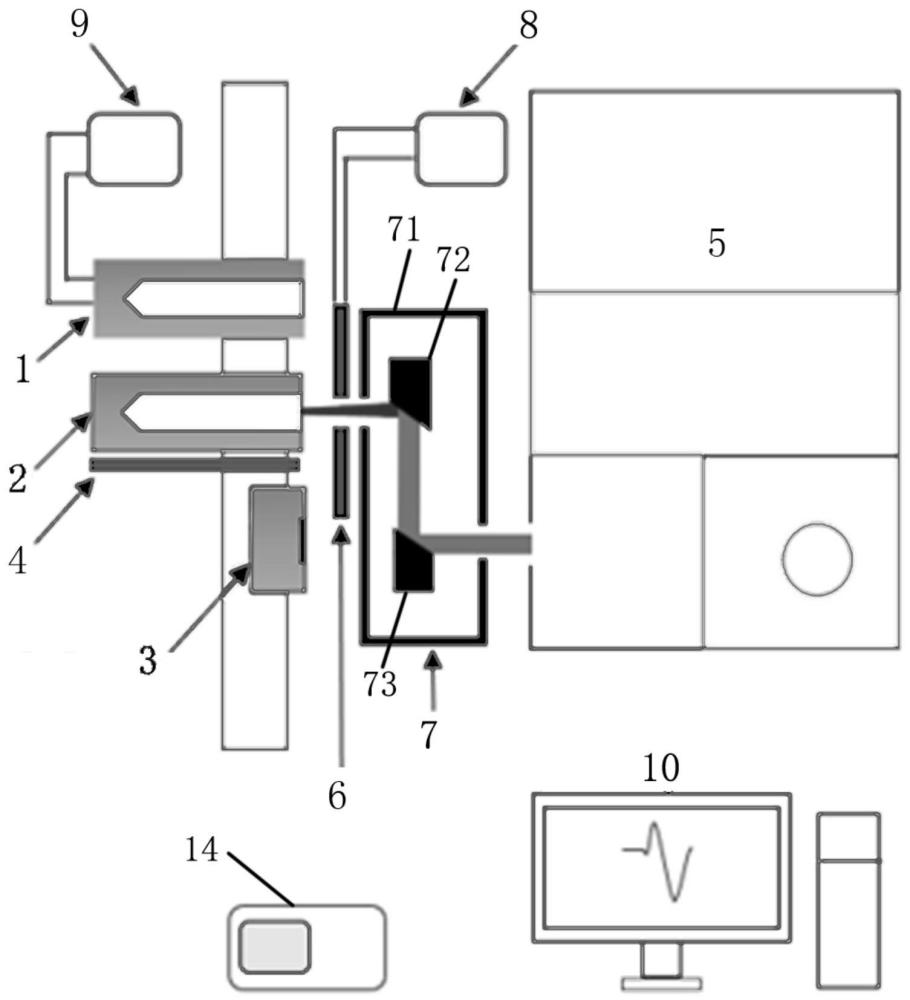一种宽温区方向光谱发射率测量装置的制作方法

本发明涉及材料光谱发射率测量,具体涉及一种宽温区方向光谱发射率测量装置。
背景技术:
1、材料光谱发射率不仅是众多研究与应用的前提,而且具有重要的科研意义和应用价值,其在定量温度测量和确定热平衡的精确计算中不可或缺[1-5]。此外,在红外遥感、工业生产、航空航天及军事等领域所涉及的许多材料都需要对光谱发射率进行准确测量[6-13]。然而光谱发射率不仅受材料本身组分、表面形貌、粗糙度以及氧化状态等因素的影响,还与温度、波长和方向密切相关[14-17],因此准确测量材料的光谱发射率并不容易。
2、近年来,国内外许多科研人员和学者致力于搭建材料光谱发射率测量装置。美国国家标准与技术研究所(nist)开发了一种基于ftir光谱仪的装置[18,19],用于测量透明材料,测量温度范围为327℃-1127℃、光谱范围为1-20μm。德国慕尼黑联邦国防军大学s.hatzl等人[20]研制了一种大气下测量高温固体材料法向光谱发射率的装置,通过样品与参考黑体进行光谱比较,用数值计算光谱比来确定样品表面温度,测量温度从500℃-1350℃、波长范围为0.6μm-15μm。日本国家计量院(nmij)搭建了一套近室温红外光谱发射率高精度测量装置[21],测量光谱范围为5-12μm,温度范围-20℃-100℃、测量精度为3%。cai etal建立了一套基于双参考黑体的材料光谱发射率测量装置[22],并通过双黑体对光谱仪的背景函数进行实时测量和校准,可以满足50℃-1000℃的光谱发射率测量,并且测量了导电二氧化硅薄膜和碳化硅在1μm-25μm波长范围内不同温度下的光谱发射率,扩展不确定度小于5%。guo et al搭建了一套基于傅里叶红外光谱仪的方向光谱发射率测量装置[23],通过旋转样品加热器来调节测量角度(0-60°),测量了727℃-1127℃温度范围内碳化硅晶片的法向光谱发射率。
3、综上所述,目前研究大多集中于法向光谱发射率的测量,涉及材料方向光谱发射率的测量很少,尤其在宽温区范围内。然而方向光谱发射率的研究在红外遥感、太阳能、辐射测温、军事伪装等领域中同样重要,例如方向光谱发射率研究是实现飞机蒙皮、坦克外壳、导弹等军事目标红外隐身的关键,太阳能电池板在不同方向上的辐射特性决定了其性能。
4、参考文献:
5、[1]j.r.howell,r.siegel,m.p.thermal radiation heat transfer,5th edition,thermal radiation heat transfer,2010.
6、[2]c.-d.wen,t.-y.chai,experimental investigation of emissivity ofaluminum alloys and application of multispectral radiation thermometry,applied thermal engineering,31(2011)2414-2421.
7、[3]green,steve,radiation thermometry:an introduction to theory,technology and techniques,measurement&control,28(1995)238-243.
8、[4]c.-d.wen,i.mudawar,mathematical determination of emissivity andsurface temperature of aluminum alloys using multispectral radiationthermometry,international communications in heat and mass transfer,33(2006)1063-1070.
9、[5]alaruri,d.sami,emissivity measurements for ysz thermal barriercoating at high temperatures using a 1.6-um single-wavelength pyrometer,optical engineering,37(1998)683-687.
10、[6]g.ohring,b.wielicki,r.spencer,b.emery,r.datla,satellite instrumentcalibration for measuring global climate change:report of a workshop,bulletinof the american meteorological society,86(2005)1303-1314.
11、[7]j.g.anderson,j.a.dykema,r.m.goody,h.hu,d.b.kirk-davidoff,absolute,spectrally-resolved,thermal radiance:a benchmark for climate monitoring fromspace,journal of quantitative spectroscopy and radiative transfer,85(2004)367-383.
12、[8]y.zhang,y.zhang,r.lu,s.shu,x.lang,l.yang,investigation of thenormal spectral band emissivity characteristic within 7.5 to 13μm formolybdenum between 100and 500℃,infrared physics&technology,88(2018)74-80.
13、[9]k.yu,h.zhang,y.liu,y.liu,study of normal spectral emissivity ofcopper during thermal oxidation at different temperatures and heating times,international journal of heat and mass transfer,129(2019)1066-1074.
14、[10]w.zhu,d.shi,z.zhu,j.sun,spectral emissivity model of steel 309sduring the growth of oxide layer at 800–1100 k,international journal of heatand mass transfer,109(2017)853-861.
15、[11]l.del campo,r.b.pérez-sáez,l.gonzález-fernández,x.esquisabel,i.fernández,p.gonzález-martín,m.j.tello,emissivity measurements onaeronautical alloys,journal of alloys and compounds,489(2010)482-487.
16、[12]j.qi,q.eri,b.kong,y.zhang,the normal spectral emittance of thereal surface from worked aero-engine nozzle,applied thermal engineering,150(2019)641-650.
17、[13]g.r.yenni,a.ambirajan,c.balaji,s.p.venkateshan,emissivityestimation of spacecraft thermal control surfaces at cryogenic temperatures–anovel experimental approach,heat and mass transfer,55(2018)1465-1476.
18、[14]c.-d.wen,i.mudawar,modeling the effects of surface roughness onthe emissivity of aluminum alloys,international journal of heat and masstransfer,49(2006)4279-4289.
19、[15]l.del campo,r.b.pérez-sáez,m.j.tello,x.esquisabel,i.fernández,armco iron normal spectral emissivity measurements,international journal ofthermophysics,27(2006)1160-1172.
20、[16]z.yuan,k.yu,l.li,g.wang,k.zhang,y.liu,new directional spectralemissivity measurement apparatus simultaneously collecting the blackbody andsample radiation,rev sci instrum,93(2022)044902.
21、[17]h.jo,j.l.king,k.blomstrand,k.sridharan,spectral emissivity ofoxidized and roughened metal surfaces,international journal of heat and masstransfer,115(2017)1065-1071.
22、[18]a.v.prokhorov,s.n.mekhontsev,l.m.hanssen,radiative properties ofblackbody calibration sources:recent advances in computer modeling,international journal of thermophysics,28(2007)2128-2144.
23、[19]l.m.hanssen,c.p.cagran,a.v.prokhorov,s.n.mekhontsev,v.b.khromchenko,use of a high-temperature integrating sphere reflectometerfor surface-temperature measurements,international journal of thermophysics,28(2007)566-580.
24、[20]s.hatzl,m.kirschner,v.lippig,t.sander,c.mundt,m.pfitzner,directmeasurements of infrared normal spectral emissivity of solid materials forhigh-temperature applications,international journal of thermophysics,34(2013)2089-2101.
25、[21]j.ishii,a.ono,s.t.i.s.f.o.engineering,fourier transformspectrometer for htermal-infrared emissivity measurements near roomtemperatures,in:conference on optical diagnostic methods for inorganicmaterials,2000.
26、[22]j.cai,y.yang,l.liao,g.lyu,material spectral emissivitymeasurement based on two reference blackbodies,international journal ofthermophysics,36(2015)3288-3296.
27、[23]y.m.guo,s.j.pang,z.j.luo,y.shuai,h.p.tan,h.qi,measurement ofdirectional spectral emissivity at high temperatures,international journal ofthermophysics,40(2018).
技术实现思路
1、针对现有技术的不足,本发明旨在提供一种宽温区方向光谱发射率测量装置。
2、为了实现上述目的,本发明采用如下技术方案:
3、一种宽温区方向光谱发射率测量装置,包括常温黑体、变温黑体、加热装置、测温仪、ftir光谱仪、光学系统和上位机;
4、所述加热装置用于对样品加热,其可旋转,以调节样品的测量角度;常温黑体、变温黑体和加热装置之间设有隔板;常温黑体连接于黑体恒温水槽,黑体恒温水槽中的水与常温黑体之间循环换热,以保持常温黑体的温度恒定;所述常温黑体、变温黑体和加热装置分别连接有温度测量机构,用于测量常温黑体、变温黑体和加热装置的温度;所述加热装置和各个温度测量机构均通讯连接于测温仪,所述测温仪从各个温度测量机构获取常温黑体、变温黑体的温度和加热装置的加热温度,并控制变温黑体和加热装置启动或停止加热;
5、所述光学系统包括恒温光阑和密闭光路结构,所述密闭光路结构包括外部壳体和设于所述外部壳体内的镀金离轴抛物面镜和平面镜,所述外部壳体的两侧分别设有光路入口和光路出口,所述光路入口和所述恒温光阑对应,光路出口和所述ftir光谱仪对应;所述恒温光阑内部中空并连通于光阑恒温水槽,光阑恒温水槽中的水与恒温光阑之间循环换热,以保持恒温光阑的温度恒定;
6、上位机和测温仪通讯连接,用于采集并记录温度数据;所述上位机还与ftir光谱仪通讯连接,用于采集光谱信号。
7、进一步地,所述加热装置、常温黑体和变温黑体均水平横向排列地设于电动移动平台上,电动移动平台和光学系统相对设置,并且可带动所述加热装置、常温黑体和变温黑体水平横向移动和上下升降。
8、进一步地,所述变温黑体包括中温黑体和高温黑体;所述加热装置包括中温样品加热器和高温样品加热器,所述中温样品加热器和高温样品加热器分别用于加热得到中温样品和高温样品。
9、更进一步地,中温黑体的工作温度为50-450℃,高温黑体的工作温度为400-1000℃。
10、更进一步地,中温样品加热器包括铁铬铝线圈和石英玻璃导热盘,所述铁铬铝线圈和石英玻璃导热盘连接并对其进行加热,所述石英玻璃导热盘用于固定中温样品;所述石英玻璃导热盘的表面喷涂有高发射率黑漆。
11、更进一步地,高温样品加热器包括u型硅钼棒、金属外壳、莫来石耐火材料和导热板,所述金属外壳的内部填充有所述莫来石耐火材料,所述导热板设于金属外壳的正面,所述u型硅钼棒设于所述导热板的背面,用于对导热板进行加热,所述导热板的背面与温度测量机构连接,高温样品固定在所述导热板的正面。
12、更进一步地,中温黑体、常温黑体和中温样品所连接的温度测量机构均为铂电阻温度计,高温黑体和高温样品所连接的温度测量机构包括s型热电偶和盛装冰水混合物的容器,所述高温黑体和高温样品分别连接有s型热电偶,所述s型热电偶的参比端置于盛装冰水混合物的容器内。
13、进一步地,所述加热装置连接于电动旋转台,所述电动旋转台可驱动所述加热装置连同样品一并转动。
14、进一步地,所述常温黑体和变温黑体均采用腔式结构,其内部具有腔体,底部呈锥角为120°的锥形结构,黑体的腔体内部喷涂高发射率涂层,涂层的发射率在3-14μm范围内不低于0.95。
15、本发明的有益效果在于:利用本发明装置,可以实现材料的便捷方向光谱发射率测量,通过分设中温黑体、高温黑体以及中温样品加热器和高温样品加热器,测量温度可达1000℃,从而实现宽温区测量。
- 还没有人留言评论。精彩留言会获得点赞!